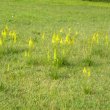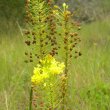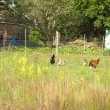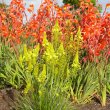| Botanical Name |
|
| Family |
Asphodeloideae - |
| Pronunciation |
BUL-bin-ee a-biss-IN-ee-kuh |
| Common Name(s) |
Afrikaans: Geelkatstert; Wildekopieva
|
| Plant Group |
- Succulent A plant having fleshy stems or leaves often adapted to dry conditions.
|
| Plant Size |
- Small to Medium
| Tree | 8m to 15m |
| Shrub | 75cm to 1m |
| Perennial/ground cover | 20cm to 40cm |
| Bulb | 30cm to 40cm |
| Succulent | 20cm to 40cm |
|
| Position |
- Partial Shade The area is in shade for part of the day and in full sun for part of the day.
- Sun The area is in full sun for all or most of the day, all year round.
|
| General Information |
- Drought Tolerance: High The plant is well adapted to arid conditions; it can survive long periods of drought and high temperatures without extra water.
- Evergreen Plants that have leaves all year round.
- Frost: Hardy The plant can withstand freezing temperatures or frost without artificial protection.
- Water Wise Plant species originating from low rainfall regions that require less water to survive and thrive than other plant species.
|
| Specific Information |
Bulbine abyssinica has large flower heads with petals tipped with brown. It forms clumps and often develops into small colonies.
|
| Ad Break |
|
| Flowers |
| Description |
small, star-shaped flowers on an upright stem up to 80 cm long
|
| Season |
- Winter to Spring Plants will seldom bloom for the entire season as given in the list, but should flower during a period within these parameters.
|
| Colour |
|
| Growth Rate |
- Fast Specifying growth rate can be very misleading as there is considerable variation of growth rate depending on type and species of plant, available water, supplementary feeding, mulching and general care, as well as the plants suitability and adaptability to the garden environment.
|
| Plant Uses |
- Accent or Focal Point A plant used to attract the attention because of its colour or form.
- Attracts bees, butterflies or other insects This plant attracts insects which can be food for birds or other creatures in your garden.
- Border A strip of ground, at the edge of a driveway or path in which ornamental plants or shrubs are planted.
- Cut Flowers Plants that provide flowers suitable for ornamental uses.
- Edging A low growing plant that provides softness or definition to the edges of a bed or walkway.
- Filler Either a fast growing tree or shrub used temporarily to fill in an area while the permanent plants grow to a desired size, or a plant used to fill gaps in borders or beds.
- Interplanting Arranging and planting plants in the garden that have different blooming times and habits of growth, extending the amount of time in which the area is in flower.
- Mass Planting Plants useful for filling a large area with just one or a few kinds of plants spaced close together. Creates a bold, dramatic effect and to reduces maintenance.
- Pioneer for new gardens A very fast growing plant, able to withstand hardship, that can be used to populate land that has recently been cleared of natural vegetation. These plants pave the way for slower-growing species by adding nutrients to the soil and creating leaf litter.
- Rock Garden An area constructed of larger rocks, arranged naturally, to emphasise the use of stones as a main element. Generally plants used do not need a lot of care.
- Suitable for coastal gardens Plants adapted to dry, sandy soil, forceful wind, limited rainfall and intense sunlight.
- Suitable for smaller gardens Such plants do not have invasive root systems, remain small or controllable and can often be grown in containers.
- Wild Garden An indigenous garden planted for the benefit of wildlife and birds. Provides food, water, a variety of mini-biomes and no poisonous chemicals are used.
|
| Distribution and Habitat |
from the Eastern Cape, through KwaZulu-Natal, Swaziland, Lesotho, Free State, North-West, Gauteng, Mpumalanga, Limpopo and north to Ethiopia, in rocky grassland, shallow soil, woodland and along seepage areas
|
| Planting Suggestions |
Plant Bulbine abyssinica in summer after flowering, in well-drained, humus rich (add compost) soil. Mulch well. Place the roots just below the surface of the soil with the crown above the soil. Water until established then only when very dry to ensure it remains water wise. Divide and replant large clumps in early spring (That's what the research says, but I query dividing during the flowering period and prefer to divide in autumn and early winter.)
|
| Medicinal Uses |
Bulbine abyssinica is much used in traditional medicine to treat dysentery, bilharzia and cracked lips.
|
| Ad Break |
|











Comments
Can i use the sap from the
Can i use the sap from the plant for my scars on my face to heal faster.
Scars are from the operation
Bulbine to reduce scars
Hi Renee
I very much doubt it. Rather speak to your doctor or chemist for advice - there are effective preparations exclusively developed for this purpose.
Regards
Lorraine
Cold-sores
Hi there
Just something interesting about this plant, for the past 8 years I've been using the sap from the leaves to help get rid of Cold-sores. With other creams the doctors prescribed me it took at least 2 weeks to get better, but with this plant it takes 4 days at most to be cured.
Thank you for your comment Marnus.
Hi Marnus
Apologies for missing your comment and thanks for sharing your knowledge.
It seems all the bulbine family are useful for skin problems. You may be interested in this article about sunburn:
http://kumbulanursery.co.za/blog/bulbine-natalensis-to-the-rescue
Kind regards
Lorraine
Hi there, I have many of this
Hi there, I have many of this plant where I noticed the leaves wilting and the plant dying. I finally discovered that the plants are infested with ants at the root ball. Little black ants. I guess they are eating the roots. Any ideas how to deter the the ants. So far I tried talcum powder, coffee grounds and organic insecticide...
Maybe not ants after all
Hi Hugo
Firstly, my sincere apologies for not answering your comment.
You have described exactly what happens to most of my bulbine varieties every year. I have taken a very close look at the base of the plants. If you pull the plants apart and open up the base of each plantlet, I can almost guarantee that you will find a tiny white grub hidden inside. These larva eat away at the flesh and this cuts off the supply of sap to the leaves which is why the leaves go brown and the rest of the plant dies as you describe, The ants move in when the grubs are there - I think they might collect the faeces or perhaps they collect the sap from the damaged plants - I am just guessing. One thing is certain: whenever a plant is in stress, you will find ants, but it is seldom the ants that are the initial problem.
Insecticide does not help with the grubs as they are safely inside the stems where insecticide cannot penetrate.
These grubs are small members of the Weevil family and are called Snout beetles. They come in all sizes up to about 15 mm long and attack all members of the Aloe family including the Bulbines. You may be interested in the following article which deals with these pests in detail:
http://kumbulanursery.co.za/blog/snout-beetle-damage-done-to-aloes
How to get rid of these little bugs? I really don't know. Most of my bulbines have died. I re-plant every year, the plants grow well, but soon after flowering starts I see the signs of the leaves going brown and I know the plants will die. Very depressing.
Kind regards
Lorraine
Discuss this plant
Share knowledge, ask a question or give an experience.